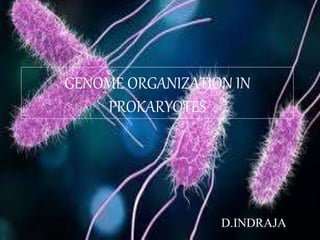
Genome organization in prokaryotes(molecular biology)
- 2. Gene: It is a unit of heridity which is transferred from a parent to offspring and held to determine some charecteristic to offspring Genome: The entire set of genetic information in an organism It is encoded in DNA or RNA in case of many viruses It includes different types of genes they are Structural genes: DNA segments that code for some specific RNAs or proteins encode for mRNAs, tRNAs, SnRNAs Functional sequences: The sequences that are regulatory elements such as initiation site, promoter site, operator site Non functional sequences: It includes introns and repetetive sequences
- 3. Nucleoid • The nucleoid (meaning nucleus-like) is an irregularly-shaped region within the cell of a prokaryote that contains all or most of the genetic material. In contrast to the nucleus of a eukaryotic cell, it is not surrounded by a nuclear membrane. The genome of prokaryotic organisms generally is a circular, double-stranded piece of DNA, of which multiple copies may exist at any time. The length of a genome varies widely, but is generally at least a few million base pairs.
- 4. • The nucleoid can be clearly visualized on an electron micrograph at high magnification, where it is clearly visible against the cytosol. Sometimes even strands of what is thought to be DNA are visible. The nucleoid can also be seen under a light microscope.by staining it with the Feulgen stain, which specifically stains DNA. The DNA- intercalating stains DAPI and ethidium bromide are widely used for fluorescence microscopy of nucleoids. • Experimental evidence suggests that the nucleoid is largely composed of about 60% DNA, plus a small amount of RNA and protein. The latter two constituents are likely to be mainly messenger RNA and the transcription factor proteins found regulating the bacterial genome. Proteins helping to maintain the supercoiled structure of the nucleic acid are known as nucleoid proteins or nucleoid-associated proteins, and are distinct from histones of eukaryotic nuclei.
- 5. • The prokaryotic chromosome structure was derived from studies of E.coli a bacterium that line in human colon in large intestine and commonly used E.coli in laboratory cloning experiment • As the DNA of E.coli is larger than the size of the cell it gets problem for packaging the problem is overcomed by supercoiling of DNA.
- 6. SUPER COILING A double helix of DNA undergoes additional twisting in the same direction or in the opposite direction from the turns in the original helix.supercoiling results when DNA is subject to same form of structural strain. A strain is introduced in the DNA to induce supercoiling • Positive super coiling twisting in lefthanded fashion • Negative super coiling twisting in right handed fashion
- 7. Genomes can be negatively supercoiled or positively supercoiled, Most bacterial genomes are negatively supercoiled during normal growth. Proteins involved in super coiling: During the 1980s and 1990s, researchers discovered that multiple proteins act together to fold and condense prokaryotic DNA. In particular, one protein called HU, which is the most abundant protein in the nucleoid, works with enzyme called topoisomerase I to bind DNA and introduce sharp bends in the chromosome, generating the tension necessary for negative supercoiling. Recent studies have also shown that other proteins, including integration host factor (IHF), can bind to specific sequences within the genome and introduce additional bends . The folded DNA is then organized into a variety of conformations that are supercoiled and wound around tetramers of the HU protein
- 8. Acessing super coiled genes: • Because there is no nuclear membrane to separate prokaryotic DNA from the ribosomes within the cytoplasm, transcription and translation occur simultaneously in these organisms. • The nucleoid usually appears as an irregularly shaped mass within the prokaryotic cell, but it becomes spherical when the cell is treated with chemicals to inhibit transcription or translation. Moreover, during transcription, small regions of the chromosome can be seen to project from the nucleoid into the cytoplasm , where they unwind and associate with ribosomes, thus allowing easy access by various transcriptional proteins . These projections are thought to explain the mysterious shape of nucleoids during active growth. When transcription is inhibited, however, the projections retreat into the nucleoid, forming spherical shape.
- 9. The Importance of DNA supercoiling DNA supercoiling is important for DNA packaging within all cells. Because the length of DNA can be thousands of times that of a cell, packaging this genetic material into the cell is difficult . Supercoiling of DNA reduces the space and allows for much more DNA to be packaged. In prokaryotes, plectonemic supercoils are predominant, because of the circular chromosome and relatively small amount of genetic material.
- 10. GENOME ORGANIZATION • Genome organization in prokaryotes takes place by FOLDED GENOME MODEL • In folded genome model the large DNA molecule in E.coli chromosome is organized in to 50 to 100 loops each of which is negatively supercoiled • RNA and proteins are both components of folded genome which can be partially relaxed by treatment with either DNAse or RNAse • DNAse removes supercoiling • RNAse removes folding
- 12. VARIATIONS IN PROKARYOTIC GENOME STRUCTURE • While most prokaryotes, like E. coli, contain a single circular DNA molecule that makes up their entire genome Exceptions Vibrio cholerae cholera - 2 circular chromosomes one for metabolism and virulence and another for remaining essential genes Borrelia burgdorferi Lyme disease - 11 copies of a single linear chromosome It cannot supercoil its linear chromosomes into a tight ball within the nucleoid; rather, these strands are diffused throughout the cell This organism is transmitted through the bite of deer ticks Archaea, a taxonomic domain composed of single-celled, nonbacterial prokaryotes share many similarities with eukaryotes, can be negatively supercoiled, positively supercoiled, or not supercoiled at all. It is important to note that archaeans are the only group of prokaryotes that use eukaryote- like histones.